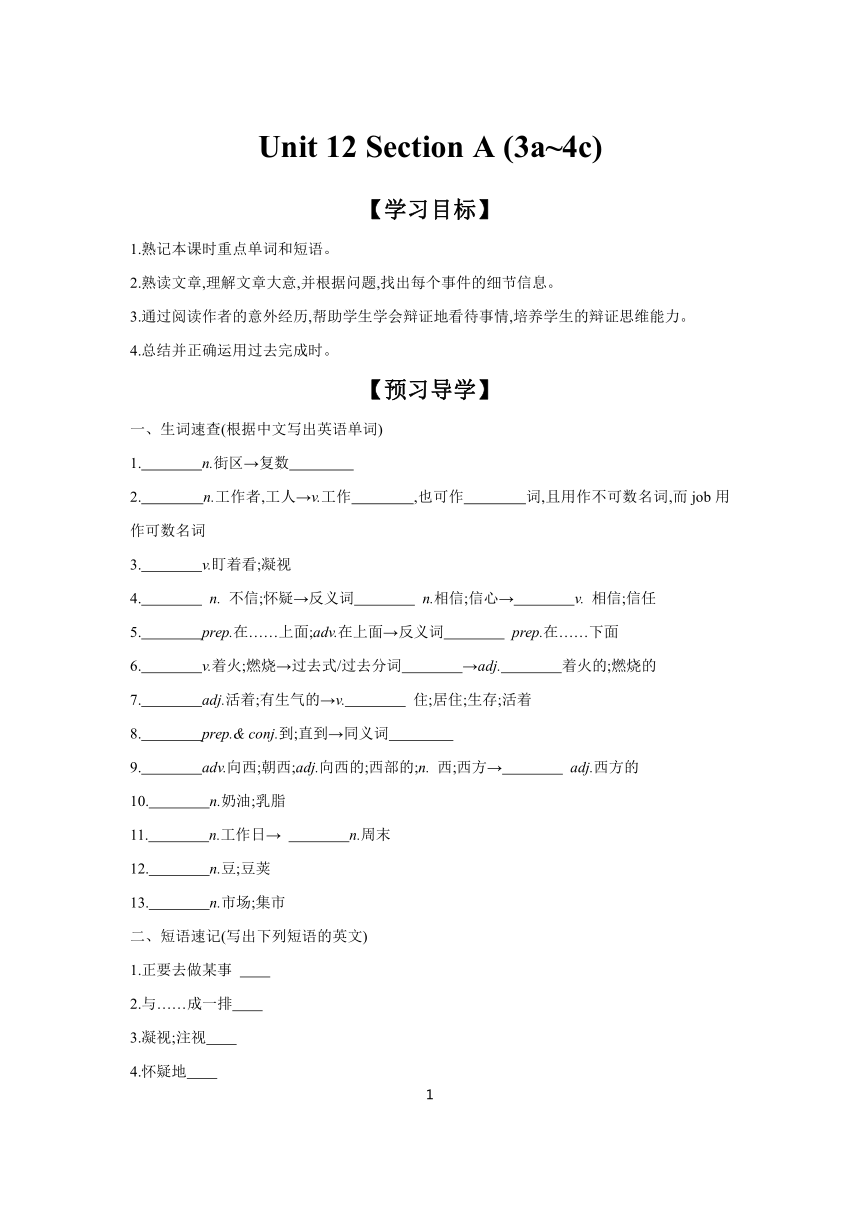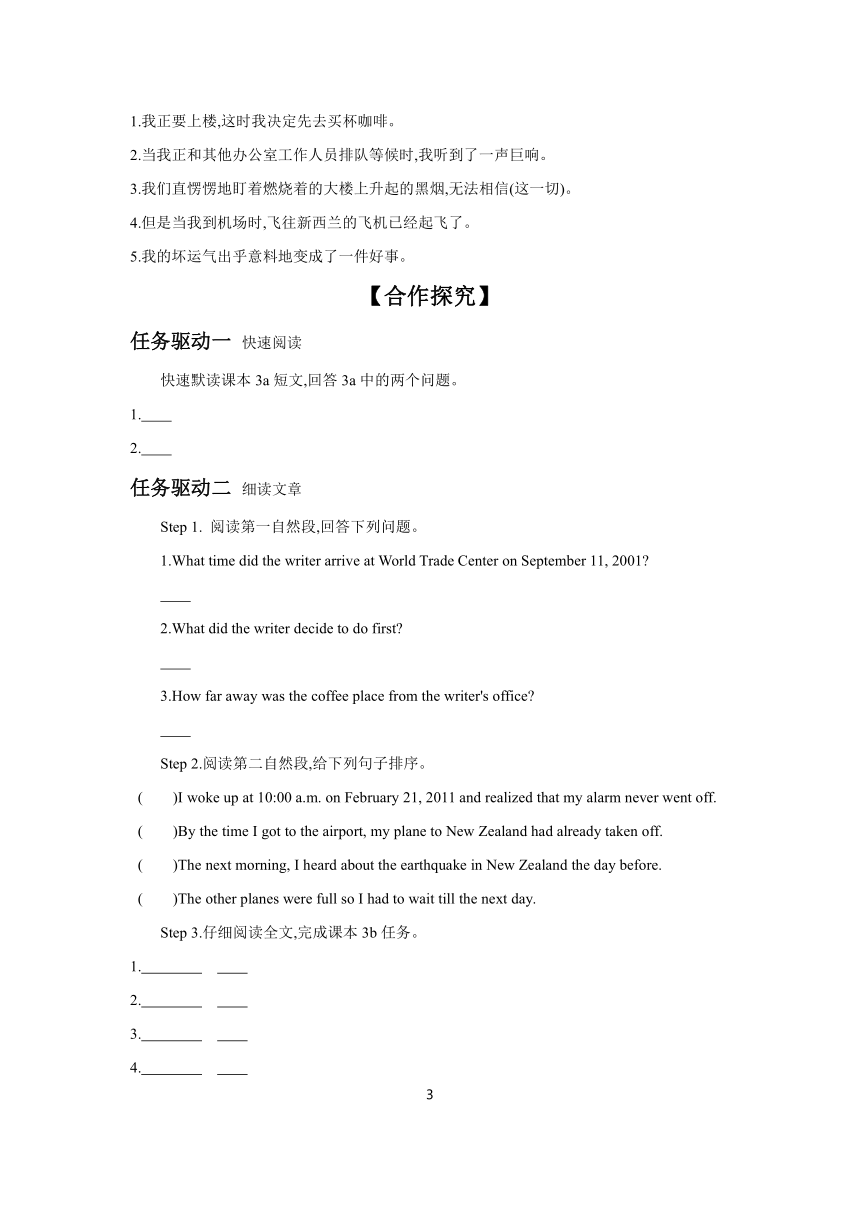人教版九年级全一册Unit 12 Life is full of the unexpected.Section A (3a~4c) 学案 (含答案)
文档属性
| 名称 | 人教版九年级全一册Unit 12 Life is full of the unexpected.Section A (3a~4c) 学案 (含答案) |  | |
| 格式 | docx | ||
| 文件大小 | 26.6KB | ||
| 资源类型 | 教案 | ||
| 版本资源 | 人教新目标(Go for it)版 | ||
| 科目 | 英语 | ||
| 更新时间 | 2024-02-21 17:24:03 | ||
图片预览



文档简介
Unit 12 Section A (3a~4c)
【学习目标】
1.熟记本课时重点单词和短语。
2.熟读文章,理解文章大意,并根据问题,找出每个事件的细节信息。
3.通过阅读作者的意外经历,帮助学生学会辩证地看待事情,培养学生的辩证思维能力。
4.总结并正确运用过去完成时。
【预习导学】
一、生词速查(根据中文写出英语单词)
1. n.街区→复数
2. n.工作者,工人→v.工作 ,也可作 词,且用作不可数名词,而job用作可数名词
3. v.盯着看;凝视
4. n. 不信;怀疑→反义词 n.相信;信心→ v. 相信;信任
5. prep.在……上面;adv.在上面→反义词 prep.在……下面
6. v.着火;燃烧→过去式/过去分词 →adj. 着火的;燃烧的
7. adj.活着;有生气的→v. 住;居住;生存;活着
8. prep.& conj.到;直到→同义词
9. adv.向西;朝西;adj.向西的;西部的;n. 西;西方→ adj.西方的
10. n.奶油;乳脂
11. n.工作日→ n.周末
12. n.豆;豆荚
13. n.市场;集市
二、短语速记(写出下列短语的英文)
1.正要去做某事
2.与……成一排
3.凝视;注视
4.怀疑地
5.暗想;心想
6.直到第二天
7.听说
8.变成
9.拥有做某事的机会
10.在(某时间点)以前
三、句子速译(把下列句子翻译成汉语)
1.I was about to go up when I decided to get a coffee first.
2.As I was waiting in line with the other office workers, I heard a loud sound.
3.We stared in disbelief at the black smoke rising above the burning building.
4.But by the time I got to the airport, my plane to New Zealand had already taken off.
5.My bad luck had unexpectedly turned into a good thing.
【答案】
一、
1.block blocks 2.worker work 名 3.stare
4.disbelief belief believe 5.above below 6.burn burnt/burnt;burned/burned burning 7.alive live
8.till until 9.west western 10.cream 11.workday weekend 12.bean 13.market
二、
1.be about to do sth. 2.in line with... 3.stare at 4.in disbelief 5.think to oneself 6.till the next day
7.hear about 8.turn into 9.get a chance to do sth.
10.by the end of
三、
1.我正要上楼,这时我决定先去买杯咖啡。
2.当我正和其他办公室工作人员排队等候时,我听到了一声巨响。
3.我们直愣愣地盯着燃烧着的大楼上升起的黑烟,无法相信(这一切)。
4.但是当我到机场时,飞往新西兰的飞机已经起飞了。
5.我的坏运气出乎意料地变成了一件好事。
【合作探究】
任务驱动一 快速阅读
快速默读课本3a短文,回答3a中的两个问题。
1.
2.
任务驱动二 细读文章
Step 1. 阅读第一自然段,回答下列问题。
1.What time did the writer arrive at World Trade Center on September 11, 2001
2.What did the writer decide to do first
3.How far away was the coffee place from the writer's office
Step 2.阅读第二自然段,给下列句子排序。
( )I woke up at 10:00 a.m. on February 21, 2011 and realized that my alarm never went off.
( )By the time I got to the airport, my plane to New Zealand had already taken off.
( )The next morning, I heard about the earthquake in New Zealand the day before.
( )The other planes were full so I had to wait till the next day.
Step 3.仔细阅读全文,完成课本3b任务。
1.
2.
3.
4.
5.
任务驱动三 读后讨论
1.借助课本3c中的单词和短语,尝试向你的同伴复述其中一件事情。
2.组内讨论以下问题。
What's your feeling about the two events which happened to the writer
◎学法指导:在熟读并理解文章的基础上,借助关键词复述文章,并学会辩证地看待生活中的意外事件。
任务驱动四 语法训练
1.过去完成时的用法。
(1)概念
过去完成时表示在过去的某一时间或动作之前已经发生或完成了的动作,它表示动作发生的时间是过去的 。
(2)结构
①肯定句:主语+ +过去分词+其他
②否定句:主语+ +过去分词+其他
③一般疑问句: +主语+过去分词+其他
(3)用法归纳
①常与before, by, by the time, by the end of等引导的时间状语(从句)连用。状语从句的谓语动词常用一般过去式。
②She ill for a week when she told me.当她告诉我时,她已病了一周了。
表示从过去某一时间开始,持续到过去另一时间的动作或状态,与“for+时间段”连用,谓语动词用延续性动词。
③Mr. Yang said that he in this city for twenty years. 杨先生说他已经在这个城市住了二十年。
主句谓语动词为一般过去时(如said, asked, found, told, thought等),其后的宾语从句通常用过去完成时。
④At that moment, I was replying to the e-mail that had arrived two days ago. 那时我正在回复两天前收到的电子邮件。
在含有定语从句的复合句中,如果叙述的是过去的事,先发生的动作常用过去完成时。
⑤Mike flew home, but his mother already passed away. Mike飞回了家,但是他的母亲已经过世了。
在and或but连接的并列句中,如果前一个并列句为一般过去时,且后一个并列句中的动作早于前一个并列句中的动作,那么后一个并列句要用过去完成时。
2.运用以上知识,完成课本4a、4b中的练习。
【答案】
任务驱动一
1.The plane hit the World Trade Center in New York and the earthquake happened in New Zealand.
2.When the plane hit the World Trade Center, he /she was getting a coffee. And because he/she had overslept and missed his/her plane, he/she was able to avoid the earthquake.
任务驱动二
Step 1.
1.At around 8:30 a.m.
2.He decided to get a coffee first.
3.Two blocks.
Step 2.
1 2 4 3
Step 3.
1.found She found a wallet on the ground.
2.east We drove east along the road.
3.above We were flying above the clouds.
4.alive His grandparents are still alive.
5.full The train was completely full.
任务驱动四
1.(1)过去 (2)①had ②hadn't ③Had (3)②had been ③had lived ⑤had
【知识超市】
[命题点一]
be about to do sth.
◎用法总结:be about to do sth.意为“即将;正要;正打算做某事”,是表示将来时的一种表达法,be about to do sth.通常不与具体的时间状语连用,而常与when引导的时间状语从句连用。例如:
I was about to go swimming when he came. 我正准备去游泳,这时他来了。
在这个结构中,be动词有人称和时态的变化,to是动词不定式符号,后跟动词原形。
对点自测
完成下列句子
1.我正要去上学,这时开始下雨了。
I go to school when it began to rain.
2.Hurry up, Tom! The train is about (start).
[命题点二]
辨析alive,living 和live
★alive作形容词,意为“活着的”,主要用作表语(有时可用作后置定语,但不用作前置定语),可用于修饰人或物。
若alive 本身有修饰语,则也可用作前置定语。例如:
He is a really alive student. 他的确是一个十分活跃的学生。
★living 可用作表语或定语,可用于修饰人或物。
alive和living 表示“活着的”,两者含义很接近,只要句法适合,有时可互换。例如:
谁是当代最伟大的诗人
正:Who is the greatest living poet
正:Who is the greatest poet alive
若需严格区分,两者仍有差别:living 通常是客观描述某人“尚在人间”或“健在”,而 alive 则主要指生与死的“界限”。例如:
He was still alive when I reached the hospital. 当我赶到医院时他还活着。
★live 通常只用作定语(前置),可用于修饰物,但一般不用于修饰人。例如:
He bought some live fish. 他买了几条活鱼。
对点自测
用alive, living和live填空
1.Is the dog or dead
2.Are your grandparents still
3.Only a few trees were left after the fire.
【答案】
命题点一
对点自测
1.was about to
2.to start
命题点二
对点自测
1.alive 2.living 3.live
2
【学习目标】
1.熟记本课时重点单词和短语。
2.熟读文章,理解文章大意,并根据问题,找出每个事件的细节信息。
3.通过阅读作者的意外经历,帮助学生学会辩证地看待事情,培养学生的辩证思维能力。
4.总结并正确运用过去完成时。
【预习导学】
一、生词速查(根据中文写出英语单词)
1. n.街区→复数
2. n.工作者,工人→v.工作 ,也可作 词,且用作不可数名词,而job用作可数名词
3. v.盯着看;凝视
4. n. 不信;怀疑→反义词 n.相信;信心→ v. 相信;信任
5. prep.在……上面;adv.在上面→反义词 prep.在……下面
6. v.着火;燃烧→过去式/过去分词 →adj. 着火的;燃烧的
7. adj.活着;有生气的→v. 住;居住;生存;活着
8. prep.& conj.到;直到→同义词
9. adv.向西;朝西;adj.向西的;西部的;n. 西;西方→ adj.西方的
10. n.奶油;乳脂
11. n.工作日→ n.周末
12. n.豆;豆荚
13. n.市场;集市
二、短语速记(写出下列短语的英文)
1.正要去做某事
2.与……成一排
3.凝视;注视
4.怀疑地
5.暗想;心想
6.直到第二天
7.听说
8.变成
9.拥有做某事的机会
10.在(某时间点)以前
三、句子速译(把下列句子翻译成汉语)
1.I was about to go up when I decided to get a coffee first.
2.As I was waiting in line with the other office workers, I heard a loud sound.
3.We stared in disbelief at the black smoke rising above the burning building.
4.But by the time I got to the airport, my plane to New Zealand had already taken off.
5.My bad luck had unexpectedly turned into a good thing.
【答案】
一、
1.block blocks 2.worker work 名 3.stare
4.disbelief belief believe 5.above below 6.burn burnt/burnt;burned/burned burning 7.alive live
8.till until 9.west western 10.cream 11.workday weekend 12.bean 13.market
二、
1.be about to do sth. 2.in line with... 3.stare at 4.in disbelief 5.think to oneself 6.till the next day
7.hear about 8.turn into 9.get a chance to do sth.
10.by the end of
三、
1.我正要上楼,这时我决定先去买杯咖啡。
2.当我正和其他办公室工作人员排队等候时,我听到了一声巨响。
3.我们直愣愣地盯着燃烧着的大楼上升起的黑烟,无法相信(这一切)。
4.但是当我到机场时,飞往新西兰的飞机已经起飞了。
5.我的坏运气出乎意料地变成了一件好事。
【合作探究】
任务驱动一 快速阅读
快速默读课本3a短文,回答3a中的两个问题。
1.
2.
任务驱动二 细读文章
Step 1. 阅读第一自然段,回答下列问题。
1.What time did the writer arrive at World Trade Center on September 11, 2001
2.What did the writer decide to do first
3.How far away was the coffee place from the writer's office
Step 2.阅读第二自然段,给下列句子排序。
( )I woke up at 10:00 a.m. on February 21, 2011 and realized that my alarm never went off.
( )By the time I got to the airport, my plane to New Zealand had already taken off.
( )The next morning, I heard about the earthquake in New Zealand the day before.
( )The other planes were full so I had to wait till the next day.
Step 3.仔细阅读全文,完成课本3b任务。
1.
2.
3.
4.
5.
任务驱动三 读后讨论
1.借助课本3c中的单词和短语,尝试向你的同伴复述其中一件事情。
2.组内讨论以下问题。
What's your feeling about the two events which happened to the writer
◎学法指导:在熟读并理解文章的基础上,借助关键词复述文章,并学会辩证地看待生活中的意外事件。
任务驱动四 语法训练
1.过去完成时的用法。
(1)概念
过去完成时表示在过去的某一时间或动作之前已经发生或完成了的动作,它表示动作发生的时间是过去的 。
(2)结构
①肯定句:主语+ +过去分词+其他
②否定句:主语+ +过去分词+其他
③一般疑问句: +主语+过去分词+其他
(3)用法归纳
①常与before, by, by the time, by the end of等引导的时间状语(从句)连用。状语从句的谓语动词常用一般过去式。
②She ill for a week when she told me.当她告诉我时,她已病了一周了。
表示从过去某一时间开始,持续到过去另一时间的动作或状态,与“for+时间段”连用,谓语动词用延续性动词。
③Mr. Yang said that he in this city for twenty years. 杨先生说他已经在这个城市住了二十年。
主句谓语动词为一般过去时(如said, asked, found, told, thought等),其后的宾语从句通常用过去完成时。
④At that moment, I was replying to the e-mail that had arrived two days ago. 那时我正在回复两天前收到的电子邮件。
在含有定语从句的复合句中,如果叙述的是过去的事,先发生的动作常用过去完成时。
⑤Mike flew home, but his mother already passed away. Mike飞回了家,但是他的母亲已经过世了。
在and或but连接的并列句中,如果前一个并列句为一般过去时,且后一个并列句中的动作早于前一个并列句中的动作,那么后一个并列句要用过去完成时。
2.运用以上知识,完成课本4a、4b中的练习。
【答案】
任务驱动一
1.The plane hit the World Trade Center in New York and the earthquake happened in New Zealand.
2.When the plane hit the World Trade Center, he /she was getting a coffee. And because he/she had overslept and missed his/her plane, he/she was able to avoid the earthquake.
任务驱动二
Step 1.
1.At around 8:30 a.m.
2.He decided to get a coffee first.
3.Two blocks.
Step 2.
1 2 4 3
Step 3.
1.found She found a wallet on the ground.
2.east We drove east along the road.
3.above We were flying above the clouds.
4.alive His grandparents are still alive.
5.full The train was completely full.
任务驱动四
1.(1)过去 (2)①had ②hadn't ③Had (3)②had been ③had lived ⑤had
【知识超市】
[命题点一]
be about to do sth.
◎用法总结:be about to do sth.意为“即将;正要;正打算做某事”,是表示将来时的一种表达法,be about to do sth.通常不与具体的时间状语连用,而常与when引导的时间状语从句连用。例如:
I was about to go swimming when he came. 我正准备去游泳,这时他来了。
在这个结构中,be动词有人称和时态的变化,to是动词不定式符号,后跟动词原形。
对点自测
完成下列句子
1.我正要去上学,这时开始下雨了。
I go to school when it began to rain.
2.Hurry up, Tom! The train is about (start).
[命题点二]
辨析alive,living 和live
★alive作形容词,意为“活着的”,主要用作表语(有时可用作后置定语,但不用作前置定语),可用于修饰人或物。
若alive 本身有修饰语,则也可用作前置定语。例如:
He is a really alive student. 他的确是一个十分活跃的学生。
★living 可用作表语或定语,可用于修饰人或物。
alive和living 表示“活着的”,两者含义很接近,只要句法适合,有时可互换。例如:
谁是当代最伟大的诗人
正:Who is the greatest living poet
正:Who is the greatest poet alive
若需严格区分,两者仍有差别:living 通常是客观描述某人“尚在人间”或“健在”,而 alive 则主要指生与死的“界限”。例如:
He was still alive when I reached the hospital. 当我赶到医院时他还活着。
★live 通常只用作定语(前置),可用于修饰物,但一般不用于修饰人。例如:
He bought some live fish. 他买了几条活鱼。
对点自测
用alive, living和live填空
1.Is the dog or dead
2.Are your grandparents still
3.Only a few trees were left after the fire.
【答案】
命题点一
对点自测
1.was about to
2.to start
命题点二
对点自测
1.alive 2.living 3.live
2
同课章节目录
- Unit 1 How can we become good learners.
- Section A
- Section B
- Unit 2 I think that mooncakes are delicious!
- Section A
- Section B
- Unit 3 Could you please tell me where the restroom
- Section A
- Section B
- Unit 4 I used to be afraid of the dark.
- Section A
- Section B
- Unit 5 What are the shirts made of?
- Section A
- Section B
- Review of Units 1-5
- Unit 6 When was it invented?
- Section A
- Section B
- Unit 7 Teenagers should be allowed to choose their
- Section A
- Section B
- Unit 8 It must belong to Carla.
- Section A
- Section B
- Unit 9 I like music that I can dance to.
- Section A
- Section B
- Unit 10 You're supposed to shake hands.
- Section A
- Section B
- Review of Units 6-10
- Unit 11 Sad movies make me cry.
- Section A
- Section B
- Unit 12 Life is full of the unexpected
- Section A
- Section B
- Unit 13 We're trying to save the earth!
- Section A
- Section B
- Unit 14 I remember meeting all of you in Grade 7.
- Section A
- Section B
- Review of Units 11-14
